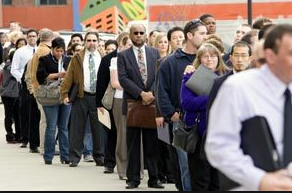US claims spike, but January durables show unexpected strength
 Courtesy of Reuters: The number of Americans filing new claims for unemployment benefits unexpectedly rose last week, but the underlying trend suggested no shift in labor market conditions.
Courtesy of Reuters: The number of Americans filing new claims for unemployment benefits unexpectedly rose last week, but the underlying trend suggested no shift in labor market conditions.
Initial claims for state unemployment benefits increased 14,000 to a seasonally adjusted 348,000, the Labor Department said on Thursday. Claims for the prior week were revised to show 2,000 fewer applications received than previously reported.
Economists polled by Reuters had forecast first-time applications for jobless benefits slipping to 335,000 in the week ended Feb. 22, which included the Presidents Day holiday. While last week’s increase pushed them to the upper end of their range so far this year, it probably does not signal labor market weakness as claims tend to be volatile around federal holidays.
The four-week moving average for new claims, considered a better measure of underlying labor market conditions as it irons out week-to-week volatility, was unchanged at 338,250. A Labor Department analyst said no states were estimated and there were no special factors affecting the state level data.
An unusually cold winter has clouded the labor market picture, with job growth braking sharply in December and recovering only marginally in January.
A third month of weak hiring is expected after snowstorms slammed the densely populated regions of the country during the survey week for February nonfarm payrolls. The claims report showed the number of people still receiving benefits after an initial week of aid rose 8,000 to 2.96 million in the week ended Feb. 15.
The so-called continuing claims have been elevated in recent weeks and some economists say the cold weather could be preventing many recipients from going out to search for work and companies to delay hiring.
Durables surprise to the upside
Orders for long-lasting U.S. manufactured goods excluding transportation unexpectedly rose last month as did a gauge of business spending plans, but that will probably not change views that factory activity is slowing.
The Commerce Department said on Thursday durable goods orders excluding transportation rose 1.1 percent, the largest increase since May, after falling 1.9 percent in December. Economists polled by Reuters had expected this category to fall 0.3 percent after a previously reported 1.3 percent decline in December.
The increase last month reflected a surge in orders for computers and electronic products, fabricated metal products and defense capital goods.
Outside these three components, details of the report were weak, with declines in orders for machinery, primary metals, electrical equipment, appliances and components, and transportation equipment. Data such as industrial production and regional factory surveys have suggested that manufacturing hit a soft patch in recent months.
Part of the slowdown reflects unusually cold weather that has disrupted activity. Manufacturing is also cooling as businesses work through a massive stock of unsold goods that was accumulated in the second half of 2013. As result, they are placing fewer orders with manufacturers, holding back factory production.
Overall durable goods orders fell 1.0 percent last month after plunging 5.3 percent in December.
Economists polled by Reuters had expected orders of items from toasters to aircraft meant to last three years or more to fall 1.5 percent last month after December’s previously reported 4.2 percent tumble.
A plunge in aircraft orders at Boeing and a drop in motor vehicles orders saw orders for transportation equipment falling 5.6 percent in January. It was the second straight month of declines in this volatile component.
Boeing reported on its website it received orders for only 38 aircraft last month, sharply down from 319 planes in December.
Non-defense capital goods orders excluding aircraft, a closely watched proxy for business spending plans, rose 1.7 percent after dropping by a revised 1.8 percent in December.
Economists had expected orders for these so-called core capital goods to slip 0.5 percent last month after a previously reported 0.6 percent fall in December.
Category: General Update










